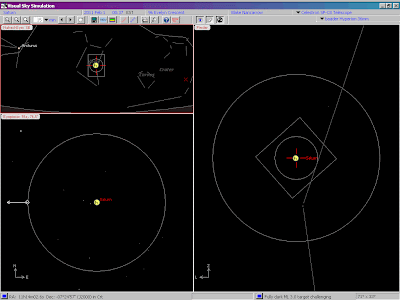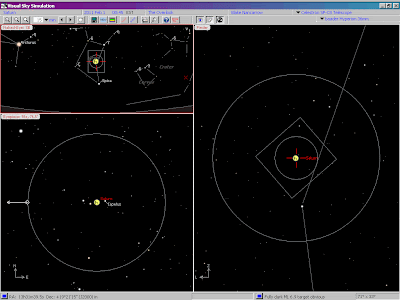- face in the right direction to begin with
- centre on the object with the finder
- view the object in the telescope
- face in the right direction to begin with (Naked Eye panel)
- zoom in a little (not too much)
- note where the finder is positioned roughly
- aim your telescope in this general area
- transition to the Finder panel comparing views
- centre on the object with the finder (Finder panel)
- use the reference stars and objects to verify your location (using the outer circle)
- centre the finder on target, i.e. shift the telescope a little
- transition to the Eyepiece panel comparing views (using the inner circle)
- view the object in the telescope (Eyepiece panel)
- use the reference stars and objects to verify your location
- shift the telescope a little, if nec.
- rotate the field of view circle, if nec.
This is not hopping. This is warping!
The only gotcha that I see to all this is that I don't think enough stars are showing in some of the panels.
The VSS window is completely dynamic! Greg is trying, as accurately as possible (he purports), to present how you will see the sky at each of these levels. He takes into consideration atmospheric extinction, Moonlight, your iris size, and the quality of your observing location sky. "Many variables that have to be tamed." And, curiously, he offers no controls here. He's the first to say, if you wanna change the atlas appearance, you need to use the Interactive Atlas instead. But then, no more 3 panels.
Maybe it is because I'm an experienced observer but I can see way more stars than he shows in the VSS. See the irony? The view he's encouraging us to use, as the New Way to rapidly get to targets, abandon your ancient star hopping techniques, burn your All About Telescopes, use the Visual Sky Simulation window, he is making broad assumptions on, completely automating the generation processes, to the point where I (and others) can't use it. Invariably, when I look at the Finder panel, it is empty.

Tell me that's not intimidating to rookies.
I found a way to hack it. Set your location's Sky brightness at zenith setting to a crazy high value. I live in Toronto. My porch overlooks the street with cobra lights and oblivious neighbours. But when I set it to a Bortle Scale value to 1 (i.e. 21.90 mag/arcsec2), I see a better representation of my urban skies.

That's better.


No comments:
Post a Comment